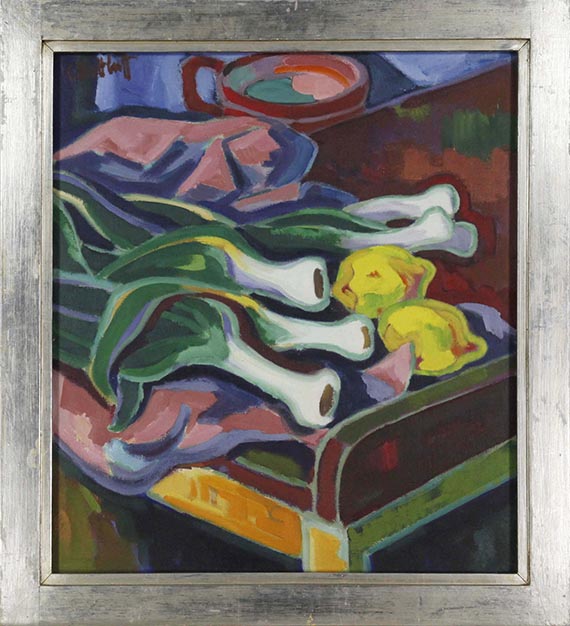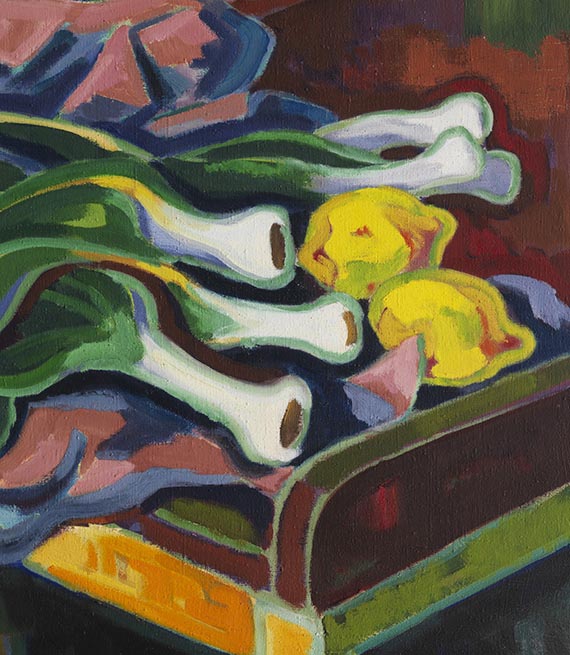386
Karl Schmidt-Rottluff
Stillleben mit Porree, 1949.
Oil on canvas
Estimate:
€ 100,000 / $ 107,000 Sold:
€ 127,000 / $ 135,890 (incl. surcharge)
Stillleben mit Porree. 1949.
Oil on canvas.
Grohmann p. 304. Signed in upper left. Signed, titled and inscribed with the work number "497" and "gewachst" on the reverse. 73 x 65 cm (28.7 x 25.5 in).
• Mirroring the eventful German history – made during the Berlin Blockade in 1948/49.
• Works from the early post-war years are very rare on the international auction market.
• The composition is particularly captivating for its clear forms and radiant colors.
• Show at the 1960 Venice Biennale.
The work is documented in the archive of the Karl and Emy Schmidt-Rottluff Foundation Berlin.
PROVENANCE: In the artist's ownership (untile at least 1960).
Hermann Gerlinger Collection, Würzburg (with the collector's stamp, Lugt 6032).
EXHIBITION: XXX. Biennale Internazionale d'Arte, Venezia, 1960, no. 86 (with the label on the stretcher).
Karl Schmidt-Rottluff zum 100. Geburtstag, Schleswig-Holsteinisches Landesmuseum, Schloss Gottorf, June 3 - August 12, 1984, cat. no. 67.
Schleswig-Holsteinisches Landesmuseum, Schloss Gottorf, Schleswig (permanent loan from the Hermann Gerlinger Collection, 1995-2001).
Kunstmuseum Moritzburg, Halle an der Saale (permanent loan from the Hermann Gerlinger Collection, 2001-2017).
Buchheim Museum, Bernried (permanent loan from the Hermann Gerlinger Collection, 2017-2022)
Brückenschlag: Gerlinger – Buchheim!, Buchheim Museum, Bernried, October 28, 2017 - February 25, 2018, p. 448.
Schmidt-Rottluff. Form, Farbe, Ausdruck, Buchheim Museum, Bernried, September 29, 2018 - February 3, 2019, p. 288 (with illu.).
LITERATURE: Heinz Spielmann (ed.), Die Maler der Brücke. Sammlung Hermann Gerlinger, Stuttgart 1995, p. 420, SHG no. 759 (with illu.).
Magdalena M. Moeller (ed.), Karl Schmidt-Rottluff. Landschaft, Figur, Stilleben, 2014, p. 136.
Hermann Gerlinger, Katja Schneider (eds.), Die Maler der Brücke. Inventory catalog Hermann Gerlinger Collection, Halle (Saale) 2005, p. 123, SHG no. 280 (with illu.)
Hermann Gerlinger, Karl Schmidt-Rottluff – ein Maler der Brücke, in: Brücke und Blaues Haus. Heckel, Kirchner, Schmidt-Rottluff und die Sammlerin Hanna Bekker vom Rath, ed. by Eva Scheid, Frankfurt a.M. 2010, pp. 25-36; here p. 30, illu. 4.
Oil on canvas.
Grohmann p. 304. Signed in upper left. Signed, titled and inscribed with the work number "497" and "gewachst" on the reverse. 73 x 65 cm (28.7 x 25.5 in).
• Mirroring the eventful German history – made during the Berlin Blockade in 1948/49.
• Works from the early post-war years are very rare on the international auction market.
• The composition is particularly captivating for its clear forms and radiant colors.
• Show at the 1960 Venice Biennale.
The work is documented in the archive of the Karl and Emy Schmidt-Rottluff Foundation Berlin.
PROVENANCE: In the artist's ownership (untile at least 1960).
Hermann Gerlinger Collection, Würzburg (with the collector's stamp, Lugt 6032).
EXHIBITION: XXX. Biennale Internazionale d'Arte, Venezia, 1960, no. 86 (with the label on the stretcher).
Karl Schmidt-Rottluff zum 100. Geburtstag, Schleswig-Holsteinisches Landesmuseum, Schloss Gottorf, June 3 - August 12, 1984, cat. no. 67.
Schleswig-Holsteinisches Landesmuseum, Schloss Gottorf, Schleswig (permanent loan from the Hermann Gerlinger Collection, 1995-2001).
Kunstmuseum Moritzburg, Halle an der Saale (permanent loan from the Hermann Gerlinger Collection, 2001-2017).
Buchheim Museum, Bernried (permanent loan from the Hermann Gerlinger Collection, 2017-2022)
Brückenschlag: Gerlinger – Buchheim!, Buchheim Museum, Bernried, October 28, 2017 - February 25, 2018, p. 448.
Schmidt-Rottluff. Form, Farbe, Ausdruck, Buchheim Museum, Bernried, September 29, 2018 - February 3, 2019, p. 288 (with illu.).
LITERATURE: Heinz Spielmann (ed.), Die Maler der Brücke. Sammlung Hermann Gerlinger, Stuttgart 1995, p. 420, SHG no. 759 (with illu.).
Magdalena M. Moeller (ed.), Karl Schmidt-Rottluff. Landschaft, Figur, Stilleben, 2014, p. 136.
Hermann Gerlinger, Katja Schneider (eds.), Die Maler der Brücke. Inventory catalog Hermann Gerlinger Collection, Halle (Saale) 2005, p. 123, SHG no. 280 (with illu.)
Hermann Gerlinger, Karl Schmidt-Rottluff – ein Maler der Brücke, in: Brücke und Blaues Haus. Heckel, Kirchner, Schmidt-Rottluff und die Sammlerin Hanna Bekker vom Rath, ed. by Eva Scheid, Frankfurt a.M. 2010, pp. 25-36; here p. 30, illu. 4.
Schmidt-Rottluff was stying at his parents' house in Rottluff when the Second World War came to an end. His artistic and material loss was tremendous. He wrote in a letter to Curt Stoermer: "We may be among the survivors, but there isn't much else left." (quoted from Magdalena Moeller (ed.), Karl Schmidt-Rottluff. Die Berliner Jahre 1946-1976, Munich 2005, p. 18). The everyday life during and after the war was characterized by hardship, but there was light at the end of the tunnel. At the end of 1946, the artist was able to return to Berlin, where he accepted a post as professor at the newly founded Academy of Fine Arts. Even though he was skeptical about the abstract tendencies prevalent in post-war Germany, he kept his finger on the pulse of the times thanks to his post at the university. As a founding member of the "Brücke", he was one of the most important German Expressionists. At that time, however, he had to reorganize and redefine his artistic position. He remained true to representational, narrative painting and drew inspiration from nature and his everyday surroundings. It is essential to consider the artist's personal circumstances. In the spirit of Expressionism, the immediate impression and sensation, remained the main source of his art. The motifs of the post-war period were determined by still lifes and interiors. These very personal pictures give us an insight into the artist's reality at the time. Created in 1949, "Stillleben mit Porree" (Still Life with Leeks) is a historical document of life in Berlin during the blockade. From June 1948 to May 1949, West Berlin was cut off from all supply routes by the Soviet Union. The only way to bring supplies into the city was through the air bridge Western Allies had set up . The will of the Berliners to survive is reflected in Schmidt-Rottluff's paintings. The subdued and reduced coloring of the war years gives way to a brighter, more intense color scheme that indicates a more optimistic spirit. What we regard a give today can be something very special the next. Filling the full format, leek and lemons are shown in close-up in the center of the image. The vegetables flown in by airlift and now in the Schmidt-Rottluffs' kitchen are waiting to be cooked. A picture full of magic and symbolic power. The still lifes created between 1948 and 1950 fulfill the same purpose as a self-portrait. They are mirrors of his state of mind. Karl Schmidt-Rottluff retained his originality and creativity into old age. His late paintings have the same rigor of color and form as his early works. Owing to their radiance, the colors are still the key protagonists, they determine the composition and the effect of the picture. Schmidt-Rottluff's conception of art, which became formative for his entire late work, was manifested in the still lifes of this period. [SM]
386
Karl Schmidt-Rottluff
Stillleben mit Porree, 1949.
Oil on canvas
Estimate:
€ 100,000 / $ 107,000 Sold:
€ 127,000 / $ 135,890 (incl. surcharge)




 Lot 386
Lot 386 

